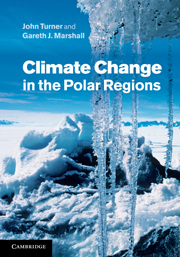Book contents
3 - The high latitude climates and mechanisms of change
Published online by Cambridge University Press: 07 September 2011
Summary
Introduction
The climates of the polar regions are characterised by long periods of continuous sunlight in summer and perpetual darkness in winter that lead to large annual cycles in many aspects of the environment. The temperatures are very low in winter and only moderate in the summer because of the low elevation of the Sun and the highly reflective nature of the snow and ice surfaces. In fact the cryosphere is a major factor in defining the climates of the high latitude areas and the interactions of the ice and snow with the ocean and atmosphere will be discussed extensively in the following sections.
Many factors are responsible for high latitude climate variability and change, which can occur on a range of timescales. On long timescales, major changes in global climate are driven by orbital and solar variability. These affect the seasonal and latitudinal distribution of energy received from the Sun. Oxygen isotope data from ocean floor sediments indicate periods when the polar ice sheets were significantly more expansive than at present, particularly in the Northern Hemisphere (glacials) and when they were of similar size to the present (interglacials). Changes in the output of the Sun can result in high latitude climatic fluctuations with periods of reduced irradiance, such as the Maunder Minimum of the seventeenth and eighteenth centuries, being detectable in some aspects of the polar climates.
- Type
- Chapter
- Information
- Climate Change in the Polar Regions , pp. 61 - 161Publisher: Cambridge University PressPrint publication year: 2011

